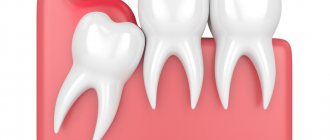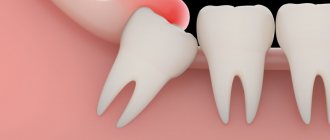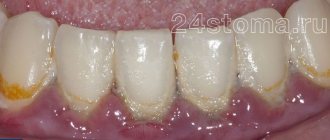Almost every person experiences discomfort during the eruption of wisdom teeth. The intensity of pain symptoms may vary in each individual case, but usually the eruption of third molars is problematic.
When a wisdom tooth grows and the gums hurt, other signs are often observed - swelling of the soft tissues of the mouth, increased temperature, impaired bowel movements, etc. People often try to cope with pathology at home: using traditional methods or anesthetic drugs. However, it must be remembered that all these measures provide only temporary relief of symptoms. Independent actions lead to a worsening of the pathology. Therefore, it is important to know under what signs you can use alternative medicine, and under what signs you should urgently consult a doctor.
Features of wisdom tooth eruption
Wisdom teeth or third molars, also known as figure eights, are the outermost teeth in a row, located at the edges of each jaw. There are four of them in total, but often not all of them erupt, and sometimes they may not grow at all.
This will not affect the chewing functions of the jaw, and if you do not have a single eight, there is no need to sound the alarm.
The eruption of third molars is possible at any age, even after 30 years; the patient’s age does not affect the course of the process. But the direction of growth, the presence of free space in a row, the structural features of the jaw can significantly influence the process - will it be painful or will it go unnoticed, will there be a health hazard and will the growth provoke the development of inflammation.
How long does swelling last?
The duration is directly related to the complexity of the surgical intervention. On average, after tooth extraction, swelling lasts for 3 days. Moreover, on the third day its development can reach its maximum. Then the swelling begins to gradually subside, at which time a hematoma may appear. The most important thing is to provide timely assistance to the body in treating the tumor and monitor whether the swollen area is amenable to simple therapeutic measures. However, if the healing period is prolonged, you should immediately consult your dentist.
Pathologies that require dental care
Eights can take several days, months, or even years to erupt. Growth is accompanied by a slight aching pain, swelling, and redness of the gums - this is the norm.
But there are a number of symptoms that indicate the development of complications and when you should consult a dentist:
- severe acute pain in the gum area;
- pain that spreads to the ear, throat, temples, head;
- increased body temperature;
- inflammation of gum tissue, purulent discharge;
- the appearance of bad breath;
- discomfort, pain when chewing;
- pain when opening the mouth;
- enlarged lymph nodes.
These are signs of inflammation that can lead to infection, loss of adjacent teeth, and sepsis.
Possible pathologies during the eruption of wisdom teeth:
- Incorrect position of the tooth, as a result, it grows sideways into the cheek, injuring, causing pain and inflammation of the soft tissues. At the same time, it causes displacement of the remaining dental units and malocclusion. In the worst case, a malignant tumor may form. It is impossible to correct the direction of growth; the incorrectly growing molar must be removed.
- If it grows towards an adjacent unit, it will damage or completely destroy its crown. The pathology is accompanied by constant severe pain, the inability to chew food normally, and talk. The solution to the problem is surgical removal.
- Pericoronitis is inflammation of the gums. Since the third molars are located in an area that is difficult to clean, leftover food, drinks, and microbes get into the gum tissue. Bacteria cause infection, inflammation, dangerous intoxication of the body, blood poisoning. Symptoms of pericoronitis include severe swelling of the gums, facial asymmetry, acute persistent pain, purulent discharge, and high fever. You should contact the clinic immediately.
First aid
Before going to the dentist, you can relieve pain at home using certain pharmaceutical products.
- Drink a painkiller drug - Nimid, Nice, Analgin, Ketanov, Paracetamol, Tempalgin.
- Place the turunda on the swollen area with a special ointment or gel - Kamistad, Dentinox, Metrogyl-Denta, Cholisal.
- Rinse the mouth with antiseptic solutions - Miramistin, Chlorhexidine and Furacilin.
You can use home help methods for three days. Next, the supervision of a professional doctor is necessary. If the pain does not go away and the swelling does not go away, then you should immediately visit a dentist to find out and eliminate the cause of the painful condition. Inflammation during pericoronaritis is relieved by washing the gingival hood with pharmaceutical antiseptic solutions: Iodopharm, Potassium permanganate, Furacilin.
How to eliminate pain and discomfort
In the absence of pathologies, it is possible to eliminate pain by taking painkillers Nurofen and Ibuprofen. Ideally, consult your dentist before using anesthetics.
It is impossible to accelerate growth or influence the process, but you can facilitate it by cutting the gum. The decision about surgery is made by the dentist based on the clinical picture.
Minor inflammations can be easily removed by rinsing the mouth with antiseptic compounds and herbal decoctions. Otherwise, all you have to do is wait for the tooth to erupt. A consultation with a specialist will allow you to identify deviations in time and prevent risks.
Why does swelling occur?
Edema is the excess accumulation of blood in the extracellular spaces of the body to speed up healing. If your cheek is swollen after wisdom tooth removal, there may be several physiological reasons:
- manifestation of an allergic reaction to the anesthetic;
- purulent focus of inflammation, usually eliminated before surgery;
- elongated roots of the tooth being removed,
- high pressure.
The listed factors are mainly individual for each organism. Most often, swelling of the cheek after wisdom tooth removal is a natural protective reaction to surgery. If no pathological factors are observed, and the dynamics of healing proceed as expected, then there is no need to worry.
If swelling occurs due to natural causes, this condition is considered normal.
How to determine natural origin?
- The tumor appears a day after the intervention.
- Pain and swelling gradually subside.
- Body temperature is normal or slightly elevated.
- Slight pain during swallowing or chewing processes.
Even if the tumor looks terrible, the first few days after surgery may be completely normal. You should be concerned if, after the allotted time, there is a tendency for pain and swelling to progress.
In what cases should you consult a doctor?
Have you had your wisdom tooth removed, and after a couple of days or more have you noticed swelling that is increasing? What to do? Such symptoms cannot be ignored. Urgently need to visit the dentist! You should contact the clinic as soon as possible in case of high fever, discharge of pus, growing swelling, severe redness of the gums and bleeding, so that the situation does not worsen. The doctor will take the necessary measures. The patient may need to wash the hole, open the abscess, and prescribe medications.
If your cheek is swollen and hurts, or swelling has taken over the area under the eye, you cannot do without medical help. Monitor your health, and if there is a sharp deterioration, call an ambulance. You should contact your dentist if you have difficulty swallowing, chewing food, or opening your mouth. The patient feels a deterioration in health when the blood clot is washed out of the socket. In its absence, inflammation often appears. Therapy consists of applying medications that will quickly relieve discomfort.
The clot may suppurate and alveolitis may develop. Self-prescribing antibiotics is unacceptable. Only a doctor can alleviate the patient’s condition, clean the hole, and place it in medicine. It happens that a hematoma develops. At first, it does not cause painful attacks or swelling. However, as soon as obvious signs appear, a visit to the dentist is mandatory. The doctor will open the hematoma and prescribe therapy.
Causes of the inflammatory process
It is not unusual for a dentist when patients come to him and complain that the gums near the wisdom tooth are swollen. No one is safe from such an incident.
Eights are specially designed, for example, they never have milk teeth predecessors, which causes them to take a long time to form, they have a different root system from the rest and begin to erupt quite late.
All people have the rudiments of molars on the distal part of the jaw, however, not all people develop completely and turn into a full-fledged tooth. In some of the population, they never begin to emerge or do not emerge completely.
Note. Wisdom teeth always grow for a long time and very slowly. This often causes discomfort, and in some cases, serious inflammatory processes, so it is important not to delay your visit to the dentist. The patient will be examined and given instructions on further actions.
How to avoid inflammation
Preventing a disease is always easier than treating it later. To prevent the figure eight from causing discomfort, you must:
- Maintain good oral hygiene. Getting to the last molar is very difficult, often impossible. You need to use special dental brushes, an irrigator, rinses, and floss.
- Do not take hormonal medications without a doctor's prescription. If long-term treatment with hormones is planned, you need to periodically take blood tests to monitor your health.
- Eat right, eat plenty of fresh fruits and vegetables. Once or twice a year, it is advisable to take a course of vitamins and minerals selected by a therapist. Ascorbic acid is very beneficial for gums. It does not allow increased bleeding to develop.
- Stop smoking and drinking alcohol. Because of these bad habits, the condition of the oral mucosa worsens, local blood circulation is impaired, and wounds heal more slowly.
- Massage your gums every day. You can do it yourself. First you need to wash your hands, and then use your fingertips to gently massage all areas of the mouth one by one.
- Buy a new brush every three months. Give preference to high-quality and proven pastes.
It is very useful to rinse with plain warm water after each meal. This will allow you to remove food debris in a timely manner.
If the gum tissue becomes inflamed at the base of the wisdom tooth, you should immediately make an appointment with the dentist. Self-medication can be dangerous.
Why does the gum around the wisdom tooth hurt?
The inflammatory process in the area of the third molar is always accompanied by swelling and pain. This allows you to notice it immediately and begin treatment in a timely manner. Before giving prescriptions to the patient, the dentist finds out the cause of the disorder. This is necessary to eliminate the infectious focus and prevent relapse.
Radiography is used to make the correct diagnosis. In the image, the doctor sees what is happening to the tissues and how far the inflammation has gone.
The main reasons look like this:
- wisdom tooth coming out;
- pericoronitis developed;
- a carious process occurs in the cervix.
Pain due to wisdom tooth cutting
Eights can appear both at 20 and at 50. And each case is a variant of the norm. You can never predict when these units will decide to show up. You can understand that a wisdom tooth is growing by the following signs:
- increase in gum volume;
- compaction and redness of tissues;
- pain when touching the inflamed area.
It happens that a unit does not cut through for a very long time. This is possible when the volume of bone structures is too large, there is insufficient space to accommodate a volumetric crown, or the unit is in a dystopic position (then it grows to the side or at an angle).
Pericoronitis as a cause of pain
The tissue surrounding the third molar may become inflamed. Plaque actively accumulates in the hole through which the figure eight erupts. A so-called gingival hood is formed. It does not allow the unit to “pass” completely and is a suitable place for the growth of bacteria and the accumulation of food debris.
Dental neck caries
The third molar has the same structure as the rest of the oral cavity, so caries on its surface is not uncommon. Then he hurts himself or the gums near him ache.
Due to the peculiarities of the position of the unit, a person usually does not have the opportunity to examine the carious cavity. Therefore, you should visit the dentist's office. Neglected caries leads to pulpitis. Then the treatment will be much more difficult.
Other reasons
Less common causes of discomfort in the figure eight area include:
- burn of mucous membranes;
- mechanical damage to tissues;
- hormonal imbalances, long-term use of hormonal medications, thyroid diseases;
- wearing incorrectly selected or low-quality removable dentures;
- stomatitis;
- gingivitis.
What can you do to relieve swelling?
Removing wisdom teeth is usually more difficult than removing incisors, canines, and other molars. The intervention causes significant trauma to the tissues surrounding the rudiment, neighboring units, and jaws. The patient must strictly follow the advice given by the dentist.
- Elimination of physical and emotional stress after a radical event. It is useful to refuse to eat for 3 hours. Until the wound heals, you should include soft, tender food in your diet, and do not touch the hole with your hands or tongue. Following these rules will help relieve cheek swelling faster.
- Swelling will be reduced by a compress of ice cubes. It is applied on the first day. The cold will also relieve pain.
- A compress of salt and soda in a ratio of 0.5: 1 is widely used. The mixture is applied for 7-15 minutes several times a day.
- Special ointments and gels will relieve swelling. It must be prescribed by a dentist.
- Worry should be avoided and stress should be avoided so as not to worsen your overall health.
- It is useful to sleep on a pillow that is raised high.
Causes of swelling of the cheek and gums during wisdom tooth growth
A “hood” appears over the erupting “third molar,” just like over any other tooth that begins to grow. It is a fold of gum, which, if the tooth is positioned correctly, should be cut by it, giving way for further growth. But, if there is a shortage of space, the “hood” remains. Residues of food can get there and, in combination with insufficient cleansing of the space closed by the gums with saliva, the growth of harmful bacteria occurs. As a result, an inflammatory process begins - pericoronitis.
This disease can be provoked by reasons related to external factors, or as a result of delaying the cutting process itself. The first case includes:
- Injury to soft tissues around a growing tooth by hard food particles or a toothbrush.
- The appearance of small ulcers or erosions on the gums.
Tightening of cutting occurs in the following cases:
- Lack of free space in the oral cavity.
- Increasing the thickness of the gums at the cutting site.
- An increase in bone tissue density associated with the absence of a preliminary presence of a baby tooth in the places where the “eight” appears.
The later a person’s wisdom tooth grows, the more severe and painful the consequences accompany the process of eruption.










